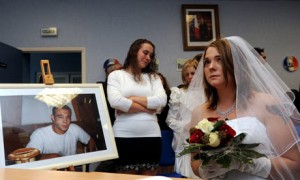‘An Invisible Loss’: Gays and Lesbians Find Comfort Hard to Come by after Partner’s Death
The New Mexican (August 28, 2010)
The Santa Fe New Mexican published a feature story last week about the often difficult and uneasy situations created when gays and lesbians are faced with the death of their partner. In so many cases, the surviving partner is not considered part of the family and is intentionally or unintentionally branded with outsider status. He or she is left out of decision-making and grieving rituals before, during and after the death of a life partner. Grief over the loss of a loved one is often compounded by a lack of understanding and/or compassion on the part of the partner’s family, which then may extend to an oblivious or even hostile larger community.
John wrote this past May about the extra end-of-life legal hoops for same-sex partners in Minnesota. Governor Tim Pawlenty vetoed a bill that would have given same-sex partners in long term relationships the legal right to the other partner’s dead body for funeral arrangements and final disposition of the remains.
Several couples are profiled in the New Mexican article. Take the instance of Tom Rotella’s partner:
When Tom Rotella’s partner died in California in 1998, his family recognized Rotella as the decision-maker. But after Rotella’s employer, the Los Angeles Public Library, announced the death in a newsletter, someone started subscribing to pornographic magazines in Rotella’s name, and there was a “mass exodus” of friends, Rotella said. “I was alone.” A contingent of colleagues did come to the funeral to support Rotella, he said, but his own parents declined, ostensibly to spare his father from learning that his son was gay. “That killed me,” he said.
Or take the case of Lynne Roberts:
Lynne Roberts’ partner fell seriously ill in 1988 after they had been together about eight years in New York City. The hospital waited for the woman’s ex-husband to sign papers allowing treatment, although Roberts was the one who brought her partner to the emergency room. While Roberts had been invited to all the family gatherings, “I was put on the periphery,” Roberts said. The family never called her with reports on her partner’s condition, and when the woman eventually died (the two were separated at the time) the family didn’t call Roberts or invite her to the cremation or burial.
These cases are disturbing and unfortunate. Of course, it’s not like this for every gay or lesbian couple dealing with the death of their partner. There are many compassionate and understanding family members, hospitals and funeral homes out there that do not discriminate or create difficult situations for same-sex partners. However, there is still a long way to go—legal and cultural—in allowing all those in the LGBT community the same rights and dignity as heterosexuals when it comes to issues of human compassion in the face of death, dying, grief and mourning. Last year’s Academy Award winning movie, A Single Man, based on the novel of same name by Chris Isherwood, dealt with one man’s grief after losing his partner in a car accident. The film is set in the early 1960s, a time when being closeted was much more a fact of life for so may gay men and women, especially since the 1969 Stonewall riots had not even yet occurred. And while much progress has been made in the intervening years, there is still a long way to go.
There are books that deal specifically with the legal, familial and cultural hurdles of same-sex partners dealing with the loss of a loved one. I’ve listed a few here.
A Legal Guide for Lesbian & Gay Couples. Denis Clifford, Frederick Hertz, Emily Doskow. 2010
Partnered Grief: When Gay and Lesbian Partners Grieve. Harold Ivan Smith, Joy Johnson. 2008
Loss of a Life Partner. Carolyn Ambler Walter. 2003
Gay Widowers: Life After the Death of a Partner. Michael Shernoff. 1997


